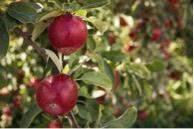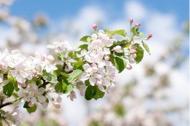Apple
-
Scientific NameMalus domestica
-
General Information
 Photo: Max, unsplashApple trees are deciduous, attractive trees native to central Asia and cultivated worldwide. There are hundreds of cultivars, including many familiar names like 'Fuji' and 'Granny Smith.' Most apples need 500 to 1,000 chill hours in winter, although some low-chill varieties are available. Red apples prefer cooler climates.
Photo: Max, unsplashApple trees are deciduous, attractive trees native to central Asia and cultivated worldwide. There are hundreds of cultivars, including many familiar names like 'Fuji' and 'Granny Smith.' Most apples need 500 to 1,000 chill hours in winter, although some low-chill varieties are available. Red apples prefer cooler climates. Photo: Jen Theodore, unsplash
Photo: Jen Theodore, unsplash -
When to Plant
January, February, and March are the best months to plant bare root trees as the trees are dormant at this time. Choose a tree with a trunk diameter of one-half inch to five-eighths inch. Trees with smaller or larger trunks take longer to become established.
Most apple trees require 500 to 1,000 hours of chill to break dormancy, or 20 to 40 chill days. (Chill hours are the cumulative number of hours that are 45 degrees F or less.) Some low-chill varieties require 400 to 600 hours, or 16 to 24 days of continuous chill exposure. These low-chill varieties may be beneficial because their buds will be more developed and less likely to be affected by the elements. Most areas of Marin receive around 800 to 1,000 hours of chill, but this varies from coast to inland, sheltered or exposed.
-
Planting
To ensure better fruit production, plant apple trees where they get six or more hours of direct sun per day during the growing season. Apples like warm days and cool nights. Avoid “frost pockets” where cold air settles in low-lying areas.
Learn more about planting bare root trees.
-
Soil Requirements
Apple trees prefer deep, well-drained, sandy clay loam.
-
Water Requirements
Apple trees require consistent, uniform soil moisture. Water is very important for young trees, especially during the first year when the root system is developing. Stress during early growth or during fruit production will reduce yields and fruit quality and may make trees more susceptible to boring insects or diseases. Moisture should be replaced well before the trees begin to show stress.
Young trees may need up to three to five gallons of water per week. Avoid frequent light watering with sprinklers as this creates a shallow root system. A garden hose, soaker hose, or drip system can provide good deep watering. Sandy soils may have to be watered every three to five days; heavier soils may need only to be watered every one and a half to two weeks. During hot weather, young trees may need to be watered more often. Avoid prolonged saturation. If weather is windy, be sure to stake young trees, otherwise they will lean in wet soils.
Do not water established trees near the trunk and lower branches, as this promotes root and crown disease. Water plants when needed around the drip line and beyond. Avoid overhead sprinklers when possible. Water deeply and infrequently (every two to three weeks). Reduce water in late summer and fall.
-
Fertilizing
Adding organic material, additives or amendments at the planting stage is not necessary as these inhibit tree roots from spreading out of its hole and may even burn the roots. A mature apple tree requires moderate fertilization. Two applications are recommended, one in early spring after planting and before bud break; the second in late summer after harvesting by mixing with the soil and away from the trunk.
Nitrogen is the element most consumed by the tree. The yellowing of leaves is a sign of nitrogen deficiency. Monitoring nitrogen effect on the tree is essential as too much of it stimulates vegetative growth thus reducing light penetration which results in reduced flower bud formation and reduced fruit yield.
As a general rule, nitrogen should be applied annually, usually during the growing season. Nitrogen fertilizer can be applied in the spring or split between spring and just after harvest. Excessive nitrogen can cause softer fruit, poor fruit color, and reduced storage and shelf life; it can also increase problems with numerous pests. If using organic fertilizer, apply a balanced fruit tree blend of 16-16-16 available from your local nursery and follow the directions. Keep fertilizers well away from the trunk and water thoroughly after application.
Potassium is necessary for fruit growth and should be worked into the soil at least six to eight inches. One application every several years is sufficient.
Calcium, Magnesium, Zinc, Iron and Manganese are micro elements in a balanced fertilizer package. Zinc is also commonly deficient. Affected trees have small new leaves. This deficiency is best corrected by spray applications. Spray with a "chelated zinc" during the growing season. Repeat if new growth still shows deficiency symptoms. Click here and here for information on essential plant nutrients
-
Pollination
Apples require cross-pollination by bees and other insects. Apples are considered self-unfruitful. For maximum production, plant at least two different apple cultivars within 50 feet of one another to ensure cross-pollination and fruit set.
Some varieties are self-fertile; however, these trees will produce more fruit if cross-pollinated. These include 'Golden Delicious' 'Braeburn' 'Granny Smith' and 'Scrumptious'.
-
Harvesting
Mature fruit can be picked or left on the tree for a few more days. However, do not leave mature fruit on the tree too long or it will not store well. Tasting the fruit is one sure method of determining ripeness. To harvest, lift fruit with a slight upward motion to see if the fruit is ready to be picked. Fruit should snap off easily. Do not pull the stem from the apple.
-
Storage
Apples keep best in your refrigerator, preferably in the crisper drawer or in an unsealed plastic bag. Refrigerate apples separately from vegetables because apples naturally release small amounts of ethylene gas that can be damaging to lettuce and other produce. Apples can be held in an open container on a table for a few days before eating, if desired, but more time at room temperature will lead to shriveling and a loss of flavor and crispness.
Small brown pits sometimes develop on the skin of apples in storage, and the underlying apple tissue is also brown. This is a common disorder of apples, called bitter pit, caused by a deficiency of calcium within the fruit as it develops on the tree. It is particularly common in large apples. These apples can be eaten without worry, but you may want to cut away the affected tissue prior to eating.
Apples can also be frozen or dried.
-
Good Varieties for Marin
Many apple varieties thrive in Marin: ‘Anna’ ‘Fuji’ ‘Gala’ ‘Granny Smith' and many more. Check your local nursery. Some trees have multiple grafts, providing more than one type of apple on a single tree.
-
Helpful Tips
Choose the right size. Apple trees are available in dwarf (eight to ten feet), semi-dwarf (ten to twenty feet), and full size (twenty feet and over). It takes two to three years for a dwarf tree to bear fruit, four to five for a semi-dwarf and five to seven for a standard size tree. For the backyard gardener, harvesting dwarfs and semi-dwarfs are much easier than a 20 foot standard size trees. Standard, full size apple trees live for about 50 years or more, whereas dwarf and semi-dwarf trees may live for 15 to 25 years, and tend to reach bearing age sooner. A dwarf tree may be pruned into a six foot shrub or shaped as an espalier on a fence.
Thin apples early, when they are the size of cherries or walnuts.
Early thinning increases the size of apples, reduces the occurrence of codling moth and other problems, and minimizes branch breakage due to weight of apples. Failure to remove the excess fruit decreases flower formation for the following year and causes the tree to only produce a crop every other year. Remove fruit by hand. Reduce the apples to one per cluster with fruiting clusters spaced about every six inches along the limb.
Learn more on pruning apple trees
-
Common Problems
Apple trees can be bothered by aphids, spider mites, codling moth, thrips, and other problems. Learn more.
-
Pests- Diseases & More
Learn more about growing apples.


